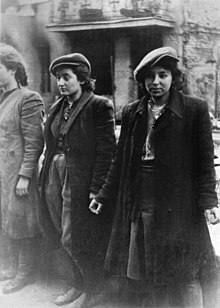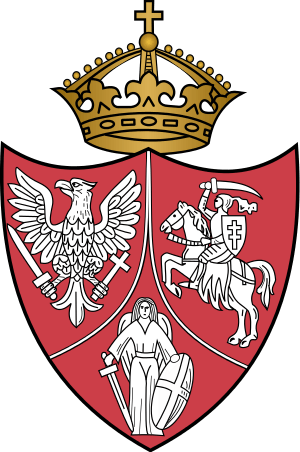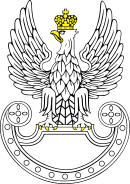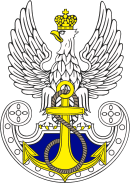Warsaw Ghetto Uprising
The Warsaw Ghetto Uprising[lower-alpha 2] was the 1943 act of Jewish resistance in the Warsaw Ghetto in German-occupied Poland during World War II to oppose Nazi Germany's final effort to transport the remaining ghetto population to Majdanek and Treblinka death camps.
| Warsaw Ghetto Uprising | |||||||
|---|---|---|---|---|---|---|---|
| Part of World War II and the Holocaust | |||||||
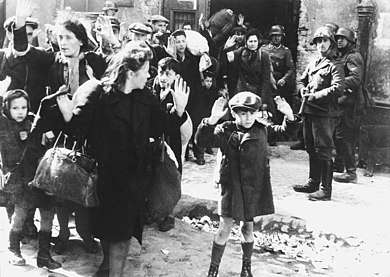 Jewish women and children forcibly removed from a bunker; one of the most iconic pictures of World War II. | |||||||
| |||||||
| Belligerents | |||||||
|
Collaborators
|
| ||||||
| Commanders and leaders | |||||||
| |||||||
| Strength | |||||||
| Daily average of 2,090 including 821 Waffen-SS | About 600[3] ŻOB and about 400[4] ŻZW fighters, plus a number of Polish fighters | ||||||
| Casualties and losses | |||||||
| 110 (17 dead, 93 wounded (German figures)).[5][lower-alpha 1] | 56,065 killed/and or captured of which approximately 36,000 deported to extermination camps (German estimate) | ||||||
After the Grossaktion Warsaw of summer 1942, in which more than a quarter of a million Jews were deported from the ghetto to Treblinka and murdered, the remaining Jews began to build bunkers and smuggle weapons and explosives into the ghetto. The left-wing Jewish Combat Organization (ŻOB) and right-wing Jewish Military Union (ŻZW) formed and began to train. A small resistance effort to another roundup in January 1943 was partially successful and spurred Polish resistance groups to support the Jews in earnest.
The uprising started on 19 April when the ghetto refused to surrender to the police commander SS-Brigadeführer Jürgen Stroop, who ordered the burning of the ghetto, block by block, ending on 16 May. A total of 13,000 Jews died, about half of them burnt alive or suffocated. German casualties were probably fewer than 150, with Stroop reporting 110 casualties [16 killed + 1 dead/93 wounded].[5]
It was the largest single revolt by Jews during World War II. The Jews knew that the uprising was doomed and their survival was unlikely. Marek Edelman, the only surviving ŻOB commander, said their inspiration to fight was "to pick the time and place of our deaths". According to the United States Holocaust Memorial Museum, the uprising was "one of the most significant occurrences in the history of the Jewish people".[6]
Background
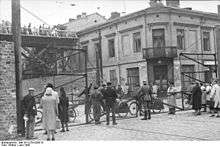

In 1939, German authorities began to concentrate Poland's population of over three million Jews into a number of extremely crowded ghettos located in large Polish cities. The largest of these, the Warsaw Ghetto, collected approximately 300,000–400,000 people into a densely packed, 3.3 km2 central area of Warsaw. Thousands of Jews died due to rampant disease and starvation under SS-und-Polizeiführer Odilo Globocnik and SS-Standartenführer Ludwig Hahn, even before the mass deportations from the ghetto to the Treblinka extermination camp began.
The SS conducted many of the deportations during the operation code-named Grossaktion Warschau, between 23 July and 21 September 1942. Just before the operation began, the German "Resettlement Commissioner" SS-Sturmbannführer Hermann Höfle called a meeting of the Ghetto Jewish Council Judenrat and informed its leader, Adam Czerniaków, that he would require 7,000 Jews a day[7] for the "resettlement to the East".[8][9] Czerniaków committed suicide once he became aware of the true goal of the "resettlement" plan. Approximately 254,000–300,000 ghetto residents died at Treblinka (most murdered outright) during the two-month-long operation. The Grossaktion was directed by SS-Oberführer Ferdinand von Sammern-Frankenegg, the SS and police commander of the Warsaw area since 1941.[10]
He was relieved of duty by SS-und-Polizeiführer Jürgen Stroop, sent to Warsaw by Heinrich Himmler on 17 April 1943.[11][12] Stroop took over from von Sammern-Frankenegg following the failure of the latter to pacify the ghetto resistance.[13]
When the deportations first began, members of the Jewish resistance movement met and decided not to fight the SS directives, believing that the Jews were being sent to labour camps and not to their deaths. But by the end of 1942, ghetto inhabitants learned that the deportations were part of an extermination process. Many of the remaining Jews decided to revolt.[14] The first armed resistance in the ghetto occurred in January 1943.[15]
On 19 April 1943, Passover eve, the Germans entered the ghetto. The remaining Jews knew that the Germans would murder them and they decided to resist to the last.[16] While the uprising was underway, the Bermuda Conference was held by the Allies from 19–29 April 1943 to discuss the Jewish refugee problem.[17] Discussions included the question of Jewish refugees who had been liberated by Allied forces and those who still remained within German-occupied Europe.[18]
The uprising
January revolt
On 18 January 1943, the Germans began their second deportation of the Jews, which led to the first instance of armed insurgency within the ghetto. While Jewish families hid in their so-called "bunkers", fighters of the ŻZW, joined by elements of the ŻOB, resisted, engaging the Germans in direct clashes.[19] Though the ŻZW and ŻOB suffered heavy losses (including some of their leaders), the Germans also took casualties, and the deportation was halted within a few days. Only 5,000 Jews were removed, instead of the 8,000 planned by Globocnik.
Hundreds of people in the Warsaw Ghetto were ready to fight, adults and children, sparsely armed with handguns, gasoline bottles, and a few other weapons that had been smuggled into the ghetto by resistance fighters.[3] Most of the Jewish fighters did not view their actions as an effective measure by which to save themselves, but rather as a battle for the honour of the Jewish people, and a protest against the world's silence.[16]
Preparations
Two resistance organizations, the ŻZW and ŻOB, took control of the ghetto. They built dozens of fighting posts and executed a number of Nazi collaborators, including Jewish Ghetto Police officers, members of the fake (German-sponsored and controlled) resistance organization Żagiew, as well as Gestapo and Abwehr agents (such as Judenrat member Dr Alfred Nossig, executed on 22 February 1943).[20] The ŻOB established a prison to hold and execute traitors and collaborators.[21] Józef Szeryński, former head of the Jewish Ghetto Police, committed suicide.[22]
Main revolt

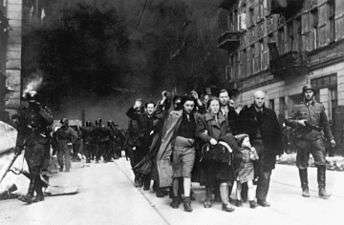
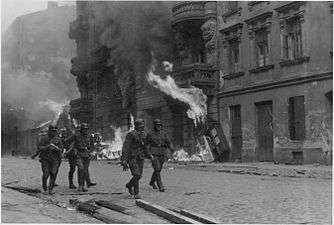
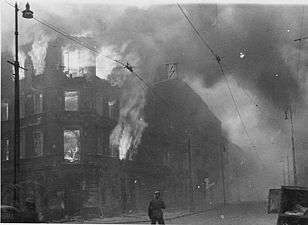

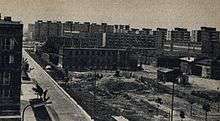
On 19 April 1943, on the eve of Passover, the police and SS auxiliary forces entered the ghetto. They were planning to complete the deportation action within three days, but were ambushed by Jewish insurgents firing and tossing Molotov cocktails and hand grenades from alleyways, sewers, and windows. The Germans suffered 59 casualties and their advance bogged down. Two of their combat vehicles (an armed conversion of a French-made Lorraine 37L light armored vehicle and an armored car) were set on fire by the insurgents' petrol bombs.[23]
Following von Sammern-Frankenegg's failure to contain the revolt, he lost his post as the SS and police commander of Warsaw. He was replaced by SS-Brigadeführer Jürgen Stroop, who rejected von Sammern-Frankenegg's proposal to call in bomber aircraft from Kraków. He led a better-organized and reinforced ground attack.
The longest-lasting defense of a position took place around the ŻZW stronghold at Muranowski Square, where the ŻZW chief leader, Dawid Moryc Apfelbaum, was killed in combat. On the afternoon of 19 April, a symbolic event took place when two boys climbed up on the roof of a building on the square and raised two flags, the red-and-white Polish flag and the blue-and-white banner of the ŻZW. These flags remained there, highly visible from the Warsaw streets, for four days.
During this fight on 22 April, SS officer Hans Dehmke was killed when gunfire detonated a hand grenade he was holding.[24] When Stroop's ultimatum to surrender was rejected by the defenders, his forces resorted to systematically burning houses block by block using flamethrowers and fire bottles, and blowing up basements and sewers. "We were beaten by the flames, not the Germans," survivor Marek Edelman said in 2007; he was deputy commander of the ŻOB and escaped the ghetto in its last days.[25] In 2003, he recalled: "The sea of flames flooded houses and courtyards. ... There was no air, only black, choking smoke and heavy burning heat radiating from the red-hot walls, from the glowing stone stairs."[26] The "bunker wars" lasted an entire month, during which German progress was slowed.[27]
While the battle continued inside the ghetto, Polish resistance groups AK and GL engaged the Germans between 19 and 23 April at six different locations outside the ghetto walls, firing at German sentries and positions. In one attack, three units of the AK under the command of Captain Józef Pszenny ("Chwacki") joined up in a failed attempt to breach the ghetto walls with explosives.[28] Eventually, the ŻZW lost all of its commanders. On 29 April, the remaining fighters from the organization escaped the ghetto through the Muranowski tunnel and relocated to the Michalin forest. This event marked the end of significant fighting.
At this point, organized defense collapsed. Surviving fighters and thousands of remaining Jewish civilians took cover in the sewer system and in the many dugout hiding places hidden among the ruins of the ghetto, referred to as "bunkers" by Germans and Jews alike. The Germans used dogs to detect such hideouts, then usually dropped smoke bombs to force people out. Sometimes they flooded these so-called bunkers or destroyed them with explosives. On occasions, shootouts occurred. A number of captured fighters lobbed hidden grenades or fired concealed handguns after surrendering. There were also clashes at night between small groups of insurgents and German patrols at night.
On 8 May, the Germans discovered a large dugout located at Miła 18 Street, which served as ŻOB's main command post. Most of the organization's remaining leadership and dozens of others committed mass suicide by ingesting cyanide, including Mordechaj Anielewicz, the chief commander of ŻOB. His deputy Marek Edelman escaped the ghetto through the sewers with a handful of comrades two days later.
On 10 May, Szmul Zygielbojm, a Bundist member of the Polish government in exile, committed suicide in London to protest the lack of action on behalf of the Jews by the Allied governments. In his farewell note, he wrote:
I cannot continue to live and to be silent while the remnants of Polish Jewry, whose representative I am, are being murdered. My comrades in the Warsaw Ghetto fell with arms in their hands in the last heroic battle. I was not permitted to fall like them, together with them, but I belong with them, to their mass grave. By my death, I wish to give expression to my most profound protest against the inaction in which the world watches and permits the destruction of the Jewish people.[29]
The suppression of the uprising officially ended on 16 May 1943, when Stroop personally pushed a detonator button to demolish the Great Synagogue of Warsaw.
Besides claiming an estimated 56,065 Jews accounted for (although his own figures showed the number to be 57,065) and noting that "The number of destroyed dug-outs amounts to 631," in his official report dated 24 May 1943, Stroop listed the following as captured booty:[30]
- 7 Polish Rifles
- 1 Russian Rifle
- 1 German Rifle
- 59 pistols of various calibers
- Several hundred hand grenades, including Polish and home-made ones .
- Several hundred incendiary bottles
- Home-made explosives
- Infernal machines with fuses
- A large amount of explosives, ammunition for weapons of all calibers, including some machine-gun ammunition.
Regarding the booty of arms, it must be taken into consideration that the arms themselves could in most cases not be captured, as the bandits and Jews would, before being arrested, throw them into hiding places or holes which could not be ascertained or discovered. The smoking out of the dug-out by our men, also often made the search for arms impossible. As the dug-outs had to be blown up at once, a search later on was out of the question. The captured hand grenades, ammunition, and incendiary bottles were at once reused by us against the bandits.
Further booty:
- 1,240 used military tunics (part of them with medal ribbons-Iron Cross and East Medal)
- 600 pairs of used trousers
- Other equipment and German steel helmets
- 108 horses, four captured in the former Ghetto (hearse)
Up to 23 May 1943 we had counted:
4.4 million Zloty; furthermore about 5 to 6 million Zloty not yet counted, a great amount of foreign currency, e.g. $14,300 in paper and $9,200 in gold, moreover valuables (rings, chains, watches, etc.) in great quantities.State of the Ghetto at the termination of the large-scale operation: Apart from 8 buildings (Police Barracks, hospital, and accommodations for housing working-parties), the former Ghetto is completely destroyed. Only the dividing walls are left standing where no explosions were carried out. But the ruins still contain a vast amount of stones and scrap material which could be used.
Sporadic resistance continued and the last skirmish took place on 5 June 1943 between Germans and a holdout group of armed Jews without connections to the resistance organizations.
Casualties
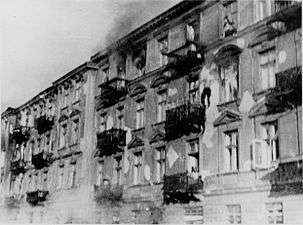
.jpg)
13,000 Jews were killed in the ghetto during the uprising (some 6,000 among them were burnt alive or died from smoke inhalation). Of the remaining 50,000 residents, almost all were captured and shipped to the death camps of Majdanek and Treblinka.
Jürgen Stroop's internal SS daily report for Friedrich Krüger, written on 16 May 1943, stated:
180 Jews, bandits and sub-humans, were destroyed. The former Jewish quarter of Warsaw is no longer in existence. The large-scale action was terminated at 20:15 hours by blowing up the Warsaw Synagogue. ... Total number of Jews dealt with 56,065, including both Jews caught and Jews whose extermination can be proved. ... Apart from 8 buildings (police barracks, hospital, and accommodations for housing working-parties) the former Ghetto is completely destroyed. Only the dividing walls are left standing where no explosions were carried out.[31]
According to the casualty lists in Stroop's report, German forces suffered a total of 110 casualties – 17 dead (of whom 16 were killed in action) and 93 injured – of whom 101 are listed by name, including over 60 members of the Waffen-SS. These figures did not include Jewish collaborators, but did include the "Trawniki men" and Polish police under his command. The real number of German losses, however, may be well higher (the Germans suffered about 300 casualties by Edelman's estimate). For propaganda purposes, the official announcement claimed the German casualties to be only a few wounded, while propaganda bulletins of the Polish Underground State announced that hundreds of occupiers had been killed in the fighting.
German daily losses of killed/wounded and the official figures for killed or captured Jews and "bandits", according to the Stroop report:
- 19 April: 1 killed, 24 wounded; 580 captured
- 20 April: 3 killed, 10 wounded; 533 captured
- 21 April: 0 killed, 5 wounded; 5,200 captured
- 22 April: 3 killed, 1 wounded; 6,580 captured; 203 "Jews and bandits" killed; 35 Poles killed outside the Ghetto
- 23 April: 0 killed, 3 wounded; 4,100 captured; 200 "Jews and bandits" killed; 3 Jews captured outside the Ghetto.Total of 19,450 Jews reported caught
- 24 April: 0 killed, 3 wounded; 1,660 captured; 1,811 "pulled out of dugouts, about 330 shot".
- 25 April: 0 killed, 4 wounded; 1,690 captured; 274 shot; "very large portion of the bandits ... captured". Total of 27,464 Jews caught
- 26 April: 0 killed, 0 wounded; 1,722 captured; 1,330 "destroyed"; 362 Jews shot. 30 Jews "displaced". Total of 29,186 Jews captured
- 27 April: 0 killed, 4 wounded; 2,560 captured of whom 547 shot; 24 Polish "bandits killed in battle"; 52 Polish "bandits" arrested. Total of 31,746 Jews caught
- 28 April: 0 killed, 3 wounded; 1,655 captured of whom 110 killed; 10 "bandits" killed and 9 "arrested". Total of 33,401 Jews caught
- 29 April: 0 killed 0 wounded; 2,359 captured of whom 106 killed
- 30 April: 0 killed 0 wounded; 1,599 captured of whom 179 killed. Total of 37,359 Jews caught
- 1 May: 2 killed, 2 wounded; 1,026 captured of whom 245 killed. Total of 38,385 Jews caught; 150 killed outside the Ghetto
- 2 May: 0 killed, 7 wounded; 1,852 captured and 235 killed. Total of 40,237 Jews caught
- 3 May: 0 killed, 3 wounded; 1,569 captured and 95 killed. Total of 41,806 Jews caught
- 4 May: 0 killed, 0 wounded; 2,238 captured, of whom 204 shot. Total of 44,089 Jews caught
- 5 May: 0 killed, 2 wounded; 2,250 captured
- 6 May: 2 killed, 1 wounded; 1,553 captured; 356 shot
- 7 May: 0 killed, 1 wounded; 1,109 captured; 255 shot. Total of 45,342 Jews caught
- 8 May: 3 killed, 3 wounded; 1,091 captured and 280 killed; 60 "heavily armed bandits" caught
- 9 May: 0 killed, 0 wounded; 1,037 "Jews and bandits" caught and 319 "bandits and Jews" shot. Total of 51,313 Jews caught; 254 "Jews and bandits" shot outside the Ghetto
- 10 May: 0 killed, 4 wounded; 1,183 caught and 187 "bandits and Jews" shot. Total of 52,693 Jews caught
- 11 May: 1 killed, 2 wounded; 931 "Jews and bandits" caught and 53 "bandits" shot. Total of 53,667 Jews caught
- 12 May: 0 killed, 1 wounded; 663 caught and 133 shot. Total of 54,463 Jews caught
- 13 May: 2 killed, 4 wounded; 561 caught and 155 shot. Total of 55,179 Jews caught
- 14 May: 0 killed, 5 wounded; 398 caught and 154 "Jews and bandits" shot. Total of 55,731 Jews caught
- 15 May: 0 killed, 1 wounded; 87 caught and 67 "bandits and Jews" shot. Total of 56,885 Jews caught
- 16 May: 0 killed, 0 wounded; 180 "Jews, bandits and subhumans destroyed". Total of 57,065 Jews either captured or killed[32]
According to Raul Hilberg, "the number cited by Stroop (16 dead, 85 wounded) cannot be rejected out of hand, but it is likely that his list was neither complete, free of errors, nor indicative of the German losses throughout the entire period of resistance, until the absolute liquidation of Jewish life in the ghetto. All the same, the German casualty figures cited by the various Jewish sources are probably highly exaggerated."[33][34] Other historians such as the French L. MacLean endorse the accuracy of official German casualty figures. On the other hand, the Stroop report vastly exaggerated the actual losses (and strength) of the resistance.
The Warsaw Ghetto Uprising was the largest single revolt by Jews during World War II.[35]
Aftermath
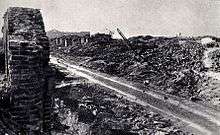
After the uprising was over, most of the incinerated houses were razed, and the Warsaw concentration camp complex was established in their place. Thousands of people died in the camp or were executed in the ruins of the ghetto. At the same time, the SS were hunting down the remaining Jews still hiding in the ruins. On 19 April 1943, the first day of the most significant period of the resistance, 7,000 Jews were transported from the Warsaw Ghetto to Treblinka extermination camp.[36] Many purportedly developed resistance groups, and helped to plan and execute the revolt and mass escape of 2 August 1943.
From May 1943 to August 1944, executions in the ruins of the ghetto were carried out by:[37]
- Officers of the Warsaw SD facility and the security police, under the supervision of Dr. Ludwig Hahn, whose seat was located in Szuch Avenue;
- Pawiak staff members;
- KL Warschau staff members;
- SS-men from the Third Battalion of the 23rd SS Regiment and the Police (Battalion III/SS-Polizei Regiment 23), commanded by Major Otton Bundtke.[lower-alpha 3]
Both open and secret executions carried out in Warsaw were repeatedly led by SS-Obersturmführer Norbert Bergh-Trips, SS-Haupturmführer Paul Werner and SS-Obersturmführer Walter Witossek. The latter often presided over the police "trio", signing mass death sentences for Polish political prisoners, which were later pronounced by the ad hoc court of the security police.[38][39]
In October 1943, Bürkl was tried and condemned to death in absentia by the Polish Resistance's Special Courts, and shot dead by the AK in Warsaw, a part of Operation Heads that targeted notorious SS officers. That same month, von Sammern-Frankenegg was killed by Yugoslav Partisans in an ambush in Croatia. Himmler, Globocnik and Krüger all committed suicide at the end of the war in Europe in May 1945.
The General Government Governor of Warsaw at the time of the Uprising, Dr. Ludwig Fischer, was tried and executed in 1947. Stroop was captured by Americans in Germany, convicted of war crimes in two different trials (U.S. military and Polish), and executed by hanging in Poland in 1952, along with Warsaw Ghetto SS administrator Franz Konrad. Stroop's aide, Erich Steidtmann, was exonerated for "minimal involvement"; he died in 2010 while under investigation for war crimes. Sturmbannführer Hermann Höfle who helped carry out the July 1942 Grossaktion Warsaw committed suicide after being arrested in 1962. Walter Bellwidt, who commanded a Waffen-SS battalion among Stroop forces, died on 13 October 1965. Hahn went into hiding until 1975, when he was apprehended and sentenced to life for crimes against humanity; he served eight years and died in 1986. SS Oberführer Arpad Wigand who served with von Sammern-Frankenberg as SS and Police Leader in Warsaw from 4 August 1941 to 23 April 1943 was tried for war crimes in Hamburg Germany in 1981 and sentenced to 12.5 years in prison; died 26 July 1983. Walter Reder reportedly served in the SS Panzer Grenadier Training Battalion III; he served a jail sentence in Italy from 1951 to 1985 for war crimes committed in 1944 in Italy, and died in 1991. Josef Blösche was tried for war crimes and executed in 1969. Heinrich Klaustermeyer was tried for war crimes in 1965 and died in 1976.
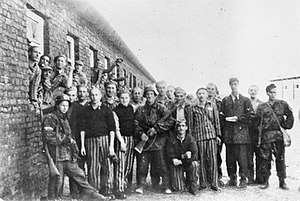
The Warsaw Ghetto Uprising of 1943 took place over a year before the Warsaw Uprising of 1944. The ghetto had been totally destroyed by the time of the general uprising in the city, which was part of the Operation Tempest, a nationwide insurrection plan. During the Warsaw Uprising, the Polish Home Army's Battalion Zośka was able to rescue 380 Jewish prisoners (mostly foreign) held in the concentration camp "Gęsiówka" set up by the Germans in an area adjacent to the ruins of former ghetto. These prisoners had been brought from Auschwitz and forced to clear the remains of the ghetto.[40] A few small groups of ghetto residents also managed to survive in the undetected "bunkers" and to eventually reach the "Aryan side".[41] In all, several hundred survivors from the first uprising took part in the later uprising (mostly in non-combat roles such as logistics and maintenance, due to their physical state and general shortage of arms), joining the ranks of the Polish Home Army and the Armia Ludowa. According to Samuel Krakowski from the Jewish Historical Institute, "The Warsaw Ghetto Uprising had a real influence ... in encouraging the activity of the Polish underground."[42]
A number of survivors of the Warsaw Ghetto Uprising, known as the "Ghetto Fighters", went on to found the kibbutz Lohamei HaGeta'ot (literally: "Ghetto Fighters'"), which is located north of Acre, Israel. The founding members of the kibbutz include Yitzhak Zuckerman (Icchak Cukierman), who represented the ŻOB on the 'Aryan' side, and his wife Zivia Lubetkin, who commanded a fighting unit. In 1984, members of the kibbutz published Daphei Edut ("Testimonies of Survival"), four volumes of personal testimonies from 96 kibbutz members. The settlement features a museum and archives dedicated to remembering the Holocaust. Yad Mordechai, a kibbutz just north of the Gaza Strip, was named after Mordechaj Anielewicz. In 2008, Israel Defense Forces Chief of Staff Gabi Ashkenazi led a group of Israeli officials to the site of the uprising and spoke about the event's "importance for IDF combat soldiers".[43]
In 1968, the 25th anniversary of the Warsaw Ghetto Uprising, Zuckerman was asked what military lessons could be learned from the uprising. He replied:
I don't think there's any real need to analyze the Uprising in military terms. This was a war of less than a thousand people against a mighty army and no one doubted how it was likely to turn out. This isn't a subject for study in military school. (...) If there's a school to study the human spirit, there it should be a major subject. The important things were inherent in the force shown by Jewish youth after years of degradation, to rise up against their destroyers, and determine what death they would choose: Treblinka or Uprising.[44]
On 7 December 1970, West German Chancellor Willy Brandt spontaneously knelt while visiting the Monument to the Ghetto Heroes memorial in the People's Republic of Poland. At the time, the action surprised many and was the focus of controversy, but it has since been credited with helping improve relations between the NATO and Warsaw Pact countries.
Many people from the United States and Israel came for the 1983 commemoration.[45]
The last surviving Jewish resistance fighter, Simcha Rotem, died in Jerusalem on 22 December 2018, at age 94.[46][47]
Opposing forces
Jewish
Two Jewish underground organisations fought in the Warsaw Uprising: the left wing Żydowska Organizacja Bojowa (ŻOB) founded in July 1942 by Zionist Jewish youth groups within the Warsaw Ghetto;[48] and the right wing Żydowski Związek Wojskowy (ŻZW), or Jewish Military Union, a national organization founded in 1939 by former Polish military officers of Jewish background which had strong ties to the Polish Home Army, and cells in almost every major town across Poland.[49][50] However both organisations were officially incorporated into the Polish Home Army and its command structure in exchange for weapons and training.[51]
Marek Edelman, who was the only surviving uprising commander from the left-wing ŻOB, stated that the ŻOB had 220 fighters and each was armed with a handgun, grenades, and Molotov cocktails. His organization had three rifles in each area, as well as two land mines and one submachine gun.[52][53][54][55] Due to its socialist leanings, the Soviets promoted the actions of ŻOB as the dominant or only party in the Warsaw Ghetto Uprising, a view often adopted by secondary sources in the West.[50]
The right-wing faction ŻZW, which was founded by former Polish officers, was larger, more established and had closer ties with the Polish resistance, making it better equipped.[19][56] Zimmerman describes the arms supplies for the uprising as "limited but real".[57] Specifically, Jewish fighters of the ŻZW received from the Polish Home Army: 2 heavy machine guns, 4 light machine guns, 21 submachine guns, 30 rifles, 50 pistols, and over 400 grenades for the uprising.[58] During the Warsaw Ghetto Uprising, ŻZW is reported to have had about 400 well-armed fighters grouped in 11 units, with 4 units including fighters from the Polish Home Army. Due to the ŻZW's anti-socialist stand and close ties with the Polish Home Army (which was subsequently outlawed by the Soviets), the Soviets suppressed publication of books and articles on ŻZW after the war and downplayed its role in the uprising, in favour of the more socialist ŻOB.
More weapons were supplied throughout the uprising, and some were captured from the Germans. Some weapons were handmade by the resistance; sometimes such weapons worked, other times they jammed repeatedly.
Shortly before the uprising, Polish-Jewish historian Emanuel Ringelblum (who managed to escape from the Warsaw Ghetto, but was later discovered and executed in 1944) visited a ŻZW armoury hidden in the basement at 7 Muranowska Street. In his notes, which form part of Oneg Shabbat archives, he reported:
They were armed with revolvers stuck in their belts. Different kinds of weapons were hung in the large rooms: light machine guns, rifles, revolvers of different kinds, hand grenades, bags of ammunition, German uniforms, etc., all of which were utilized to the full in the April "action". (...) While I was there, a purchase of arms was made from a former Polish Army officer, amounting to a quarter of a million złoty; a sum of 50,000 złoty was paid on account. Two machine guns were bought at 40,000 złoty each, and a large amount of hand grenades and bombs.[59][60]
Due to the nature of the conflict and that it took place within the confines of German-guarded Warsaw Ghetto, the role of the Polish Home Army was primarily one of ancillary support; namely, the provision of arms, ammunition and training.[56][61] Although the Home Army's stocks were meager, and general provision of arms limited,[56] the right-wing ŻZW received significant quantities of armaments, including some heavy and light machine guns, submachine guns, rifles, pistols and grenades.[lower-alpha 4]
Polish
The Polish Home Army also disseminated information and appeals to help the Jews in the ghetto, both in Poland and by way of radio transmissions to the Allies, which fell largely on deaf ears.[62] During the uprising, the Polish Resistance units from the Polish Home Army[2] and the communist Gwardia Ludowa attacked German units near the ghetto walls and attempted to smuggle weapons, ammunition, supplies, and instructions into the ghetto. The failure to break through German defences limited supplies to the ghetto, which was otherwise cut off from the outside world by a German-ordered blockade.[28]
In mid-April at 4 am, the Germans began to liquidate the Warsaw Ghetto, closed down the remnants of the Jews with a police cordon, went inside tanks and armored cars and carried out their destructive work. We know that you help the martyred Jews as much as you can, I thank you, my countrymen, on my own and the government's behalf, I am asking you to help them in my own name and in the government, I am asking you for help and for extermination of this horrible cruelty.
— Supreme Commander of the Polish Armed Forces in the West and Prime Minister of the Polish government-in-exile gen. Władysław Sikorski – The content of the leaflet published in May 1943 in a circulation of 25,000 by Council for Aid to Jews calling for help for Jews.[63]
The command of the Home Army ordered its sabotage units, Kedyw, to carry a series of actions around the walls against the German units under the code name Ghetto Action.[64][65] Between 19 and 23 April 1943, the Polish resistance engaged the Germans at six different locations outside the ghetto walls, shooting at German sentries and positions and in one case attempting to blow up a gate.[65][66] The Polish Home Army fought in 4 units with the ŻZW in Muranowska Street having climbed into the ghetto via secret tunnels dug by the ŻZW. A National Security Corps unit commanded by Henryk Iwański ("Bystry") reportedly fought inside the ghetto along with ŻZW and subsequently both groups retreated together (including 34 Jewish fighters) to the so-called Aryan side.[67] Several ŻOB commanders and fighters also later escaped through the tunnels with assistance from the Poles and joined the Polish underground (Home Army).[62]
From April 24, daily patrols against Germans near the ghetto, aimed at eliminating the Germans and training our own (Home Army) branches- up to now without own losses. Some Germans were eliminated every day.
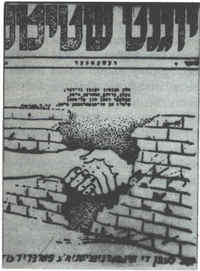 Poster printed by ŻOB: "All people are equal brothers; Brown, White, Black and Yellow. To separate peoples, colors, races, Is but an act of cheating!"
Poster printed by ŻOB: "All people are equal brothers; Brown, White, Black and Yellow. To separate peoples, colors, races, Is but an act of cheating!".jpg) Commemorative pennant of ŻZW – Jewish Military Union.
Commemorative pennant of ŻZW – Jewish Military Union.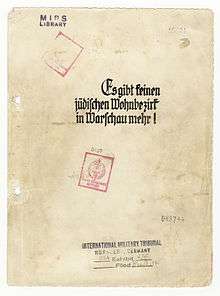 The cover page of The Stroop Report with International Military Tribunal in Nuremberg markings.
The cover page of The Stroop Report with International Military Tribunal in Nuremberg markings.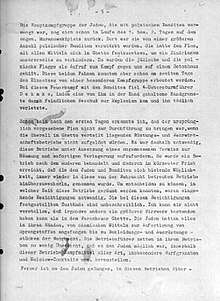 Page 5 of Stroop Report describing German fight against "Juden mit polnischen Banditen" – "Jews with Polish bandits".[24]
Page 5 of Stroop Report describing German fight against "Juden mit polnischen Banditen" – "Jews with Polish bandits".[24] Continuation 27 April 1943 describing fight against "jüdisch-polnische Wehrformation" ("Jewish-Polish armed formation").[24]
Continuation 27 April 1943 describing fight against "jüdisch-polnische Wehrformation" ("Jewish-Polish armed formation").[24]
On the other hand, despite Polish fighters joining the struggle, some survivors criticized gentile Poles for not providing sufficient support. In her book On Both Sides of the Wall, Vladka Meed, who was a member of the left-wing ŻOB, devoted a chapter to the insufficient support from the Polish resistance.[69] Indeed, records confirm that the leftist ŻOB received less weaponry and no fighters from the Polish Home Army, unlike the right-wing ŻZW with whom the Home Army had close ties and ideological similarities.[19][52][57]
German


Ultimately, the efforts of the Jewish resistance fighters proved insufficient against the German occupation system. According to Hanna Krall, the German task force dispatched to put down the revolt and complete the deportation action numbered 2,090 men armed with a number of minethrowers and other light and medium artillery pieces, several armored vehicles, and more than 200 machine and submachine guns.[52][53][54][55] Its backbone consisted of 821 Waffen-SS paramilitary soldiers from five SS Panzergrenadier reserve and training battalions and one SS cavalry reserve and training battalion. The other forces were drawn from the Ordnungspolizei (Orpo) order police (battalions from the 22nd and 23rd regiments), Warsaw personnel of the Gestapo and the Sicherheitsdienst (SD) intelligence service, one battalion each from two Wehrmacht (Heer) railroad combat engineers regiments, a Wehrmacht battery of anti-aircraft artillery, a detachment of multinational (commonly but inaccurately referred to by the Germans and Jews alike as "Ukrainians"[70]) ex-Soviet POW "Trawniki-Männer" auxiliary camp guards trained by the SS-Totenkopfverbände at Trawniki concentration camp, and technical emergency corps.
Several Gestapo jailers from the nearby political prison Pawiak, led by Franz Bürkl, volunteered to join the "hunt" for the Jews. A force of 363 officers from the Polish Police of the General Government (so-called Blue Police) was ordered by the Germans to cordon the walls of the ghetto. Warsaw fire department personnel were also forced to help in the operation.[31] Jewish policemen were used in the first phase of the ghetto's liquidation and subsequently summarily executed by the Gestapo.[23]
Stroop later remarked:[13]
I had two battalions of Waffen-SS, one hundred army men, units of Order Police, and seventy-five to a hundred Security Police people. The Security Police had been active in the Warsaw Ghetto for some time, and during this program it was their function to accompany SS units in groups of six or eight, as guides and experts in ghetto matters.[71]

By his own words, Stroop reported that after he took command on 19 April 1943, the forces at his disposal totaled 31 officers and 1,262 men:[31][73]
|
|
Stroop's report listed ultimate forces at his disposal as 36 officers and 2,054 men:[74]
|
|
His casualty[5] lists also include members of four other Waffen-SS training and reserve units (1st SS Panzer Grenadier; 2nd SS Panzer Grenadier; 4th SS Panzer Grenadier; 5th SS Panzer Grenadier Training Battalions). Polish police came from the Kommissariarts 1st, 7th and 8th. There is also evidence that German Police of the SSPF of Lubin took part in the liquidation of the Warsaw Ghetto Jews, as did the I Battalion of the 17th SS Police Regiment.
In popular culture
The uprising is the subject of numerous works, in multiple media, such as Aleksander Ford's film Border Street (1948),[75] John Hersey's novel The Wall (1950), Leon Uris' novel Mila 18 (1961), Jack P. Eisner's autobiography The Survivor (1980),[76] Andrzej Wajda's films A Generation (1955), Samson (1961), Holy Week (1995)[77] and Jon Avnet's film Uprising (2001).
The photograph of a boy surrendering outside a bunker, with Trawniki with submachine guns in the background, became one of the best-known photographs of World War II and the Holocaust:[lower-alpha 5] He is said to represent all 6 million Jewish Holocaust victims.[lower-alpha 6]
See also
- Destruction of Warsaw
- Sobibor Uprising
- Białystok Ghetto Uprising
- Ghetto uprising
- Battle of Muranów Square
Notes
- Jewish and Polish sources claim 300 killed
- Yiddish: אױפֿשטאַנד אין װאַרשעװער געטאָ, romanized: Ufshtand in Varshever Geto; Polish: powstanie w getcie warszawskim; German: Aufstand im Warschauer Ghetto
- Bundtke's Battalion stayed in the former ghetto and worked on pacifying it after the official suppression of the uprising.
- Specifically, Jewish fighters of the Jewish Military Union (ŻZW) received from the Polish Home Army: 2 heavy machine guns, 4 light machine guns, 21 submachine guns, 30 rifles, 50 pistols, and over 400 grenades for the ghetto uprising.[58]
References
- Marian Apfelbaum (2007). Two Flags: Return to the Warsaw Ghetto. Gefen Publishing House Ltd. p. 15. ISBN 978-965-229-356-5.
- Joshua D. Zimmerman (5 June 2015). The Polish Underground and the Jews, 1939–1945. Cambridge University Press. p. 216. ISBN 978-1-107-01426-8.
- Guttman, John (March 2000). "World War II: Warsaw Ghetto Uprising". World War II Magazine. Retrieved 2 May 2012.
- Maciej Kledzik (18 April 2008). "Zapomniani żołnierze ŻZW". Rzeczpospolita (in Polish). Retrieved 7 November 2012.
- Stroop (2009), pp. 25-30.
- Freilich, Miri; Dean, Martin (2012). "Warsaw". In Geoffrey P., Megargee; Dean, Martin; Hecker, Mel (eds.). Ghettos in German-Occupied Eastern Europe. Encyclopedia of Camps and Ghettos, 1933–1945. 2. Translated by Fishman, Samuel. Bloomington: United States Holocaust Memorial Museum. p. 459. ISBN 978-0-253-00202-0.CS1 maint: ref=harv (link)
- Hillel Seidman (1997). The Warsaw Ghetto Diaries. Targum Press. p. 58. ISBN 978-1-56871-133-1.
- Mlynarczyk, Jace Andrzej (2004). "Treblinka – ein Todeslager der "Aktion Reinhard"". In Musial, Bogdan (ed.). "Aktion Reinhard" – Die Vernichtung der Juden im Generalgouvernement (in German). Osnabrück: Fibre. pp. 257–281.
- Court of Assizes in Düsseldorf, Germany. Excerpts From Judgments (Urteilsbegründung). AZ-LG Düsseldorf: II 931638.
- The Nizkor Project, Statement by Stroop to CMP investigators about his actions in the Warsaw Ghetto (24 February 1946) Wiesbaden, Germany, 24 February 1946.
- Moshe Arens, Who Defended The Warsaw Ghetto? Archived 26 May 2006 at the Wayback Machine (The Jerusalem Post)
- "Jürgen Stroop". Jewish Virtual Library.
- "Ferdinand von Sammern-Frankenegg". Jewish Virtual Library.
- "Warsaw Ghetto Uprising". United States Holocaust Memorial Museum. Retrieved 18 May 2014.
- Voices From the Inferno: Holocaust Survivors Describe the Last Months in the Warsaw Ghetto – January 1943: The First Armed Resistance in the Ghetto An online exhibition by Yad Vashem
- Voices From the Inferno: Holocaust Survivors Describe the Last Months in the Warsaw Ghetto – January 1943: Fighters in the Warsaw Ghetto An online exhibition by Yad Vashem
- "United States Department of State / Foreign relations of the United States diplomatic papers, 1943. General (1943)", "Bermuda Conference to consider the refugee problem, April 19–28, 1943, and the implementation of certain of the conference recommendations", s. 134–249.
- Medoff, Dr. Rafael. "The Allies' Refugee Conference—A "Cruel Mockery"". Archived from the original on 13 May 2004.
- David Wdowiński (1963). And we are not saved. New York: Philosophical Library. p. 222. ISBN 0-8022-2486-5. Note: Chariton and Lazar were never co-authors of Wdowiński's memoir. Wdowiński is considered the "single author".
- "The Warsaw Ghetto Uprising, by Marek Edelman". Writing.upenn.edu. Retrieved 28 January 2012.
- "Benjamin Wald". Jewish Virtual Library.
- "Josef "Andzi" Szerynski". Jewish Virtual Library.
- "World War II: Warsaw Ghetto Uprising". Historynet.com. Retrieved 28 January 2012.
- Stroop (1943).
- "Last Warsaw ghetto revolt commander honours fallen comrades". European Jewish Press. 20 April 2007. Retrieved 2 May 2012.
- "Europe | Warsaw Jews mark uprising". BBC News. 20 April 2003. Retrieved 7 November 2012.
- Voices From the Inferno: Holocaust Survivors Describe the Last Months in the Warsaw Ghetto – January 1943: In the Bunkers During the Uprising, An online exhibition by Yad Vashem
- Stefan Korbonski The Polish Underground State: A Guide to the Underground, 1939–1945 Archived 27 September 2011 at the Wayback Machine
- "The Last Letter from the Bund Representative with the Polish National Council in Exile". Jewishvirtuallibrary.org. Retrieved 7 November 2012.
- Stroop (1943), pp. 77–78.
- "The Warsaw Ghetto: The Stroop Report - "The Warsaw Ghetto Is No More" (May 1943)". Jewish Virtual Library.
- "Online transcript of Stoop's report in German and English translation". Holocaust-history.org. Retrieved 13 September 2017.
- Israel Gutman, The Jews of Warsaw, 1939–1945: Ghetto, Underground, Revolt, Indiana University Press, 1982 (p.393–394)
- Raul Hilberg, The Destruction of the European Jews, Third Edition, Yale University Press, 2003 (volume 2, p. 537)
- "Jewish uprisings in Ghettos and Camps, 1941–1944". United States Holocaust Memorial Museum. Retrieved 2 May 2012.
- "Treblinka Day By Day". Holocaustresearchproject.org. 10 November 1942. Retrieved 28 January 2018.
- Bogusław Kopka: Konzentrationslager Warschau.. op.cit, p. 26, 60, 62.
- Władysław Bartoszewski: Warszawski pierścień śmierci... op.cit., p. 431.
- Regina Domańska: Pawiak... op.cit, p. 417.
- Voices From the Inferno: Holocaust Survivors Describe the Last Months in the Warsaw Ghetto – Clearing the Remains of the Ghetto. An online exhibition by Yad Vashem
- Voices From the Inferno: After the Uprising: Life Among the Ruins of the Warsaw Ghetto. An online exhibition by Yad Vashem
- Samuel Krakowski War of the Doomed – Jewish Armed Resistance in Poland, 1942–1944 ISBN 0-8419-0851-6, p. 213-14, Holmes & Meier Publishers 1984
- Azoulay, Yuval. "IDF Chief, in Warsaw: Israel, its army are answer to Holocaust", Haaretz, 29 April 2008.
- A. Polonsky, (2012), The Jews in Poland and Russia, Volume III, 1914 to 2008, p. 537
- Krajewski, Stanisław (2005). Poland and the Jews: reflections of a Polish Polish Jew. kow: Wydawnictwo Austeria. p. 151. ISBN 8389129221.
- "Warsaw ghetto uprising's last fighter passes away at age 94". Ynetnews. 22 December 2018. Retrieved 23 December 2018.
- "Last Warsaw Ghetto Uprising fighter dies". Deutsche Welle. 23 December 2018. Retrieved 23 December 2018.
- Call to Armed Self-Defense, from Ha-Shomer Ha-Zair newspaper in the Warsaw Underground Jutrznia ("Dawn"), March 28, 1942.
- Moshe Arens (2005). "The Jewish Military Organization (ŻZW) in the Warsaw Ghetto". Holocaust and Genocide Studies. 19 (2)
- Maciej Kledzik (October 2002). "ŻZW; Appelbaum w cieniu Anielewicza". Rzeczpospolita (in Polish). 10 (12). 2002-10-11. Retrieved 2006-05-09.
- Stefan Korbonski, The Polish Underground State, pp. 123-124 and 130. Jews Under Occupation Archived 2011-09-27 at the Wayback Machine
- Krall, Hanna (2008). Zdazyc przed Panem Bogiem (in Polish). Wydawnictwo a5. p. 83. ISBN 83-61298-02-9.
- Krall, Hanna (1986). Shielding the Flame: An intimate conversation with Dr Marek Edelman, the last surviving leader of the Warsaw Ghetto Uprising. transl. by Joanna Stasinska Weschler, Lawrence Weschler. Henry Holt & Company. p. 95. ISBN 0-03-006002-8.
- Krall, Hanna (1992). To Outwit God. transl. by Joanna Stasinska Weschler, Lawrence Weschler. Northwestern University Press. p. 218. ISBN 0-8101-1050-4.
- Krall, Hanna (1992). To Outwit God. transl. by Joanna Stasinska Weschler, Lawrence Weschler. Northwestern University Press. p. 218. ISBN 0-8101-1075-X.
- Andrzej Sławiński, Warsaw Ghetto Uprising and The Polish Home Army – Questions and Answers. Translated from Polish by Antoni Bohdanowicz. Article on the pages of the London Branch of the Polish Home Army Ex-Servicemen Association. Retrieved 14 March 2008.
- Peter Kenez (January 2009). Murray Baumgarten; Peter Kenez; Bruce Allan Thompson (eds.). The Attitude of the Polish Home Army (AK) to the Jewish Question during the Holocaust: the Case of the Warsaw Ghetto Uprising. University of Delaware Press. pp. 121–122. ISBN 978-0-87413-039-3.
- Richard C. Lukas (28 August 2012). Forgotten Holocaust: The Poles Under German Occupation 1939–1944. Hippocrene Books. p. 175. ISBN 978-0-7818-1302-0.
- Moshe Arens, "Flags over the Warsaw Ghetto: The Untold Story of Warsaw Ghetto Uprising", Gefen Publishing House 2007 ISBN 9652293563 page 186.
- Yosef Kermisch, "To live with honour and die with honour! Selected documents from the Warsaw Ghetto Undergroung Archives. Oneg Shabbat", Jerusalem, Yad Vashem, 1986.
- Richard C. Lukas (1997). Forgotten Holocaust: The Poles under German Occupation 1939–1944. Hippocrene Books. ISBN 0-7818-0901-0.
- Barczynski, Roman (2001). "Addendum 2: Facts about Polish Resistance and Aid to Ghetto Fighters". Americans of Polish Descent, Inc. Retrieved 1 May 2012.
- Wroński (1971).
- Strzembosz (1978), page 103.
- Witkowski (1984).
- Józef Garliński Hitler's Last Weapons: The Underground War against the V1 and V2, Times Books, New York 1978
- Stefan Korbonski, "The Polish Underground State: A Guide to the Underground, 1939–1945", pages 120–139, Excerpts Archived 27 September 2011 at the Wayback Machine
- Strzembosz (1983), p. 283.
- On Both Side of the Wall, pp. 94–109, New York: Holocaust Library, 1972, ISBN 0-89604-012-7
- USHMM: Recognize someone? Askari or Trawniki guards peer into a doorway past the bodies of Jews killed during the suppression of the Warsaw Ghetto Uprising. The original German caption reads: "Askaris used during the operation". Photo Archives. Hostile commentator: Bruno Hajda, denaturalized former guard at Trawniki, tried in the U.S., February 1996 (No. 97-2362).
- "Statement by Stroop to Investigators About His Actions in the Warsaw Ghetto". Jewishvirtuallibrary.org. 24 February 1946. Retrieved 4 May 2012.
- Moczarski (1984), p. 103.
- Stroop Report 19 April 1943 at JPFO Site.
- Stroop (1943), p. 7.
- "Border-Street – Trailer – Cast – Showtimes". The New York Times. Retrieved 7 November 2012.(subscription required)
- "Jack Eisner, 77, Holocaust Chronicler, Dies". The New York Times. 30 August 2003.
- "Andrzej Wajda. Official Website of Polish movie director – Films – "The Holy Week"". Wajda.pl. Retrieved 7 November 2012.
- Maltz, Judy (3 March 2011). "Holocaust Studies / A picture worth six million names". Haaretz. Retrieved 23 September 2018.
- "How A Little Boy Became the Face of The Holocaust". Time Magazine (100 Photographs | The Most Influential Images of All Time). Retrieved 23 September 2018.
- Kirsch, Adam (23 November 2010). "Caught on Film". Tablet Magazine. Retrieved 23 September 2018.
Bibliography
Primary sources
- Moczarski, Kazimierz (1981). Missing or empty
|title=(help)CS1 maint: ref=harv (link) - Moczarski, Kazimierz (1984). Conversations with an Executioner. Englewood Cliffs, N.J.: Prentice Hall. ISBN 978-0-300-09546-3.CS1 maint: ref=harv (link) Original in Polish: PDF 1.86 MB.
In Other languages
- Stroop, Jürgen (22 April 1943). Es gibt keinen jüdischen Wohnbezirk – in Warschau mehr! [There is no Jewish residential district - in Warsaw anymore!] (PDF) (Report) (in German). Archived from the original (PDF) on 2 December 2013.CS1 maint: ref=harv (link)
- Stroop, Jürgen (2009). Żydowska Dzielnica Mieszkaniowa W Warszawie Już Nie Istnieje! [The Jewish Residential District In Warsaw Does Not Exist Now!] (PDF) (in Polish). Warsaw: Institute of National Remembrance Jewish Historical Institute. ISBN 978-83-7629-455-1.CS1 maint: ref=harv (link)
Stroop, Jürgen (2009) [22 April 1943]. "Es gibt keinen jüdischen Wohnbezirk – in Warschau mehr!" [There is no Jewish residential district - in Warsaw anymore!]. Żydowska Dzielnica Mieszkaniowa W Warszawie Już Nie Istnieje! (in German). pp. 109–. - Strzembosz, Tomasz (1983). Akcje zbrojne podziemnej Warszawy 1939–1944 [Armed actions of underground Warsaw 1939–1944] (in Polish). Warszawa: Państwowy Instytut Wydawniczy. ISBN 83-060-0717-4.CS1 maint: ref=harv (link)
- Witkowski, Henryk (1984). Kedyw okręgu warszawskiego Armii Krajowej w latach 1943-1944 [Kedyw of Warsaw district of the Home Army in the years 1943–1944] (in Polish). Warszawa: Instytut Wydawniczy Związków Zawodowych. ISBN 83-202-0217-5.CS1 maint: ref=harv (link)
- Wroński, Stanisław (1971). Polacy i Żydzi 1939–1945 (in Polish). Warsaw: Książka i Wiedza.CS1 maint: ref=harv (link)
Further reading
- Edelman, Marek (1990). The Ghetto Fights: Warsaw, 1941–43. London: Bookmarks Publications. ISBN 0-906224-56-X.
- Gebhardt-Herzberg, Sabine (2003). "Das Lied ist geschrieben mit Blut und nicht mit Blei": Mordechaj Anielewicz und der Aufstand im Warschauer Ghetto (in German). Bielefeld: S. Gebhardt-Herzberg. ISBN 3-00-013643-6.
- Goldstein, Bernard (2005). Five Years in the Warsaw Ghetto. Oakland: AK Press. p. 256. ISBN 1-904859-05-4.
- Jahns, Joachim (2009). Der Warschauer Ghettokönig (in German). Leipzig: Dingsda-Verlag. ISBN 978-3-928498-99-9.
- Meckl, Markus (2008). "The Memory of the Warsaw Ghetto Uprising". European Legacy. 13 (7): 815–824.
- Paulsson, Gunnar S. (2002). Secret City: The Hidden Jews of Warsaw, 1940–1945. New Haven: Yale University Press. ISBN 0-13-171918-1. Review
External links
| Wikimedia Commons has media related to Warsaw Ghetto Uprising. |
- Voices From the Inferno: Holocaust Survivors Describe the Last Months in the Warsaw Ghetto, an online exhibition by Yad Vashem
- Rare color photo (not colorized) from Warsaw Ghetto Uprising by Zbigniew Borowczyk (visible Church of St. Anthony of Padua at 31/33 Senatorska Street and burning ghetto).
- The Warsaw Ghetto archive (including The Stroop Report) at Jewish Virtual Library
- Stroop Report online in German and English
- Marek Edelman, The Warsaw Ghetto Uprising
- Pre and post war pictures of the Warsaw Ghetto uprising
- Rokhl Auerbakh: Literature as Social Service & the Warsaw Ghetto Soup Kitchen
- Teach about the Warsaw Ghetto Uprising: Classroom Lesson Plans from the Jewish Partisan Educational Foundation

